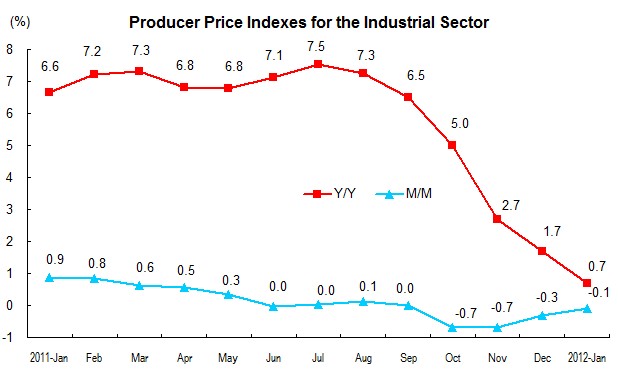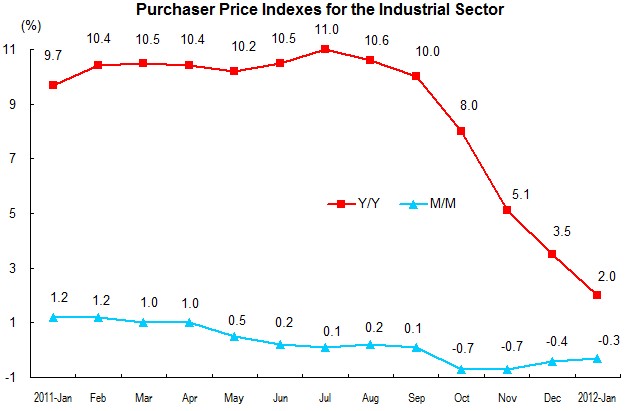Producer Prices for the Industrial Sector for January
In January 2011, Producer Price Index (PPI) for manufactured goods increased 0.7 percent year-on-year, and 0.1 percent dropped month-on-month. The purchasing price index for manufactured goods went up by 2.0 percent year-on-year, and 0.3 percent decreased month-on-month.
1. Year-on-Year Changes of Prices of Different Categories
The year-on-year change of producer prices for means of production increased 0.3 percent. In which, producer prices for mining and quarrying industry increased 6.1 percent; that of raw materials industry increased 1.7 percent, while that of manufacturing and processing industry decreased 0.9 percent. Producer prices for consumer goods went up by 2.1 percent. Of which, producer prices for foodstuff increased 3.5 percent, that of clothing increased 3.1 percent, that of commodities up by 1.6 percent, while that of durable consumer goods dropped 0.2 percent.
The year-on-year purchaser price indexes for ferrous metals and non-ferrous metals, decreased 1.1 and 2.5 percent respectively, that of fuel and power increased 6.6 percent, that of agricultural and sideline products went up by 3.9, that of textile raw materials rose 2.6 percent, and that of building materials and non-metallic grew by 2.5 percent.
2. Month-on-Month Changes of Prices of Different Categories
The month-on-month change of producer prices for means of production decreased 0.1 percent. Of the total, producer prices for mining and quarrying industry decreased 0.8 percent; that of raw materials industry increased 0.2 percent, that of machining industry down by 0.2 percent. Producer prices for consumer goods grew by 0.1 percent month-on-month. Of which, producer prices for foodstuff increased 0.2 percent; that of clothing up by 0.1 percent, that of commodities remained same level, and that of durable consumer goods rose 0.2 percent.
The month-on-month purchaser price indexes for fuel and power increased 0.2 percent, that of agricultural and sideline products remained the same level, that of ferrous metals, non-ferrous metals and chemical raw material decreased 1.1, 0.8 and 0.5 percent respectively.
Price Indexes for the Industrial Sector in January January M/M(%) Y/Y(%) I. Producer Price Indexes -0.1 0.7 Means of production -0.1 0.3 Mining and quarrying -0.8 6.1 Raw materials 0.2 1.7 Processing -0.2 -0.9 Means of subsistence 0.1 2.1 Food 0.2 3.5 Clothing 0.1 3.1 Articles for daily use 0.0 1.6 Durable consumer goods 0.2 -0.2 II. Purchaser Price Indexes -0.3 2.0 Fuel and Power 0.2 6.6 Ferrous Metals -1.1 -1.1 Non-ferrous Metal Materials and Wires -0.8 -2.5 Chemical Raw Materials -0.5 0.3 Wood and Pulp -0.2 1.8 Building Materials and Non-metallic -0.4 2.5 Other Industrial Raw Materials and Semi-products -0.1 1.0 Agricultural and Sideline Products 0.0 3.9 Textile Raw Materials -0.3 2.6


Annotations:
1. Explanatory Notes
Producer Price Index for manufactured goods consists of producer price index and purchaser price index.
The industrial producer price index reflects the trend and level of prices change when the products are sold for the first time.
The industrial purchaser price index reflects the trend and level of prices change for the products purchased by the industrial enterprises as intermediate inputs.
2. Statistical Coverage
Starting from the year 2011, statistical surveys of industrial producer prices cover prices for over 11,000 products from 1702 subclasses in 525 classes, 191 groups and 39 industrial divisions; and the statistical surveys of industrial purchaser prices cover prices for over 6,000 industrial products from over 900 subclasses.
3. Data Collection
Industrial producer prices are collected from combined surveys of key businesses and typical businesses. Starting from 2011, the key businesses are those with their turnover from primary activities over 20 million yuan, and the typical businesses are those with less than 20 million yuan. The surveys cover about 60,000 industrial enterprises in over 400 cities across the country.
